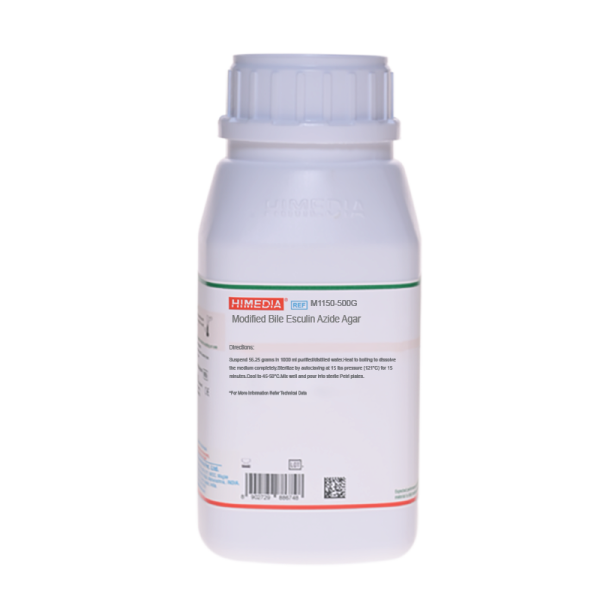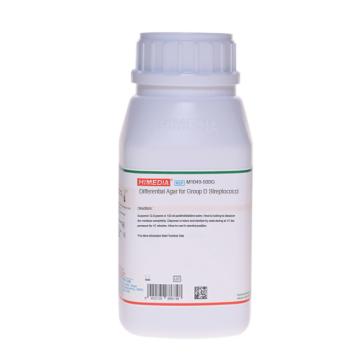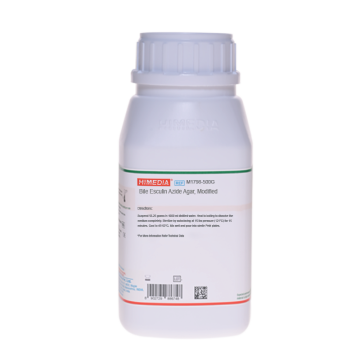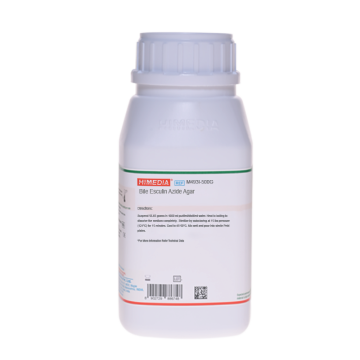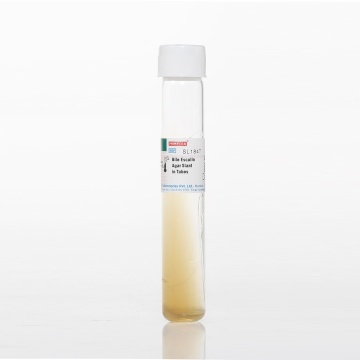 Your enquiry has been submitted
Your enquiry has been submitted
Modified Bile Esculin Azide Agar
Intended Use:
Recommended for selective isolation and enumeration of group D Streptococci.
Composition**
| Ingredients | g/L |
|---|---|
| Tryptone | 17.000 |
| Peptone | 3.000 |
| Yeast extract | 5.000 |
| Bile# | 10.000 |
| Sodium chloride | 5.000 |
| Sodium citrate | 1.000 |
| Esculin | 1.000 |
| Ferric ammonium citrate | 0.500 |
| Sodium azide | 0.250 |
| Agar | 13.500 |
Final pH (at 25°C): 7.1±0.2
**Formula adjusted, standardized to suit performance parameters # Equivalent to Oxgall
Directions
Suspend 56.25 grams in 1000 ml purified/distilled water. Heat to boiling to dissolve the medium completely. Sterilize by autoclaving at 15 lbs pressure (121°C) for 15 minutes. Cool to 45-50°C. Mix well and pour into sterile Petri plates.
Principle And Interpretation
Group D Streptococci possess the group D lipoteichoic acid antigen in their cell walls. Group D species, are predominant normal inhabitants of the human gastrointestinal tract, are termed as faecal streptococci or Enterococci (1). The unique ability of Enterococci to split esculin was reported by Meyer and Schonfeld (2). Enterococci and group D streptococci hydrolyze esculin to esculetin and dextrose, which reacts with ferric citrate producing brownish black precipitate (3). The use of esculin hydrolysis in identification of Enterococci was first cited by Rochaix (4). However, other tests such as salt tolerance should be performed for identifying Enterococci (5). Modified Bile Esculin Azide Agar was formulated according to Isenberg et al (6), Swan (7), Facklam and Moody (5) and Meyer and Schonfeld (8). They reported that esculin hydrolysis and bile tolerance permit the isolation and identification of group D streptococci in 24 hours.
Tryptone, peptone, yeast extract provide all essential growth nutrients. Streptococci hydrolyze esculin to esculetin which reacts with ferric ions to form a dark brown to black coloured complex (3). Bile inhibits most of the gram-positive bacteria other than Enterococci. Sodium azide inhibits gram-negative organism except some Proteus species.
Type of specimen
Clinical samples - Faeces; Food and dairy samples; Water samples
Specimen Collection and Handling:
For water samples, follow appropriate techniques for sample collection, processing as per guidelines and local standards (8).
For food and dairy samples, follow appropriate techniques for sample collection and processing as per guidelines (9,10,11).
For clinical samples follow appropriate techniques for handling specimens as per established guidelines (12,13).
After use, contaminated materials must be sterilized by autoclaving before discarding.
Warning and Precautions :
In Vitro diagnostic use. For professional use only. Read the label before opening the container. Wear protective gloves/protective clothing/eye protection/face protection. Follow good microbiological lab practices while handling specimens and culture. Standard precautions as per established guidelines should be followed while handling clinical specimens. Safety guidelines may be referred in individual safety data sheets.
Limitations
- Individual organisms differ in their growth requirement and may show variable growth patterns on the medium.
Performance and Evaluation
Performance of the medium is expected when used as per the direction on the label within the expiry period when stored at recommended temperature.
Quality Control
Appearance Cream to brownish yellow homogeneous free flowing powder
Gelling Firm, comparable with 1.35% Agar gel
Colour and Clarity of prepared medium Medium amber coloured clear to slightly opalescent solution with a bluish tinge forms in Petri plates.
Reaction Reaction of 5.63% w/v aqueous solution at 25°C. pH: 7.1±0.2
pH 6.90-7.30
Cultural Response
Cultural characteristics observed after an incubation at 35-37°C for 18-24 hours
| Organism | Inoculum (CFU) | Growth | Recovery | Esculin Hydrolysis |
|---|---|---|---|---|
| Enterococcus faecalis ATCC 29212 (00087*) | 50-100 | luxuriant | >=50% | positive reaction, blackening of medium around the colony |
| Proteus mirabilis ATCC 25933 | 50-100 | fair-good | 30-40% | negative reaction |
| Streptococcus pyogenes ATCC 19615 | 50-100 | none-poor | <=10% | negative reaction |
| Streptococcus bovis ATCC 27960 | 50-100 | luxuriant | >=50% | positive reaction, blackening of medium around the colony |
| Staphylococcus aureus subsp. aureus ATCC 25923(00034*) | 50-100 | good | 40-50% | negative reaction |
Key: *Corresponding WDCM numbers.
Storage and Shelf Life
Store between 10-30°C in a tightly closed container and the prepared medium at 20-30°C. Use before expiry date on the label. On opening, product should be properly stored dry, after tightly capping the bottle in order to prevent lump formation due to the hygroscopic nature of the product. Improper storage of the product may lead to lump formation. Store in dry ventilated area protected from extremes of temperature and sources of ignition. Seal the container tightly after use. Product performance is best if used within stated expiry period.
Disposal
User must ensure safe disposal by autoclaving and/or incineration of used or unusable preparations of this product. Follow established laboratory procedures in disposing of infectious materials and material that comes into contact with sample must be decontaminated and disposed of in accordance with current laboratory techniques (12,13).
Reference
- Koneman E. W., Allen S. D., Janda W. M., Schreckenberger P. C., Winn W. C. Jr., 1992, Colour Atlas and Textbook of Diagnostic Microbiology, 4th Ed., J. B. Lippinccott Company.
- Meyer K. and Schonfeld H., 1926, Zentralbl Bakteriol Parasitnek Infectionskr. Hyg. Abt. Oxig. 99 : 402.
- MacFaddin J. F., 1985, Media for Isolation-Cultivation-Identification-Maintenance of Medical Bacteria, Vol. 1, Williams and Wilkins, Baltimore.
- Rochaix E. R., 1924, Comt Rend Soc. Biol. 90 : 771
- Facklam R. and Moody M., 1970, Appl. Microbiol. 20 (2): 245.
- Isenberg H. D., Goldberg D., and Sampson J., 1970, Appl. Microbiol., 20 (3): 433
- Swan A., 1954, J. Clin. Pathol., 7 : 160
- Lipps WC, Braun-Howland EB, Baxter TE, eds. Standard methods for the Examination of Water and Wastewater, 24th ed. Washington DC:APHA Press; 2023.
- Salfinger Y., and Tortorello M.L., 2015, Compendium of Methods for the Microbiological Examination of Foods, 5th Ed., American Public Health Association, Washington, D.C.
- American Public Health Association, Standard Methods for the Examination of Dairy Products, 1978, 14th Ed., Washington, D.C.
- Wehr H. M. and Frank J. H., 2004, Standard Methods for the Microbiological Examination of Dairy Products, 17th Ed.,APHA Inc., Washington, D.C.
- Isenberg, H.D. Clinical Microbiology Procedures Handbook 2nd Edition.
- Jorgensen, J.H., Pfaller, M.A., Carroll, K.C., Funke, G., Landry, M.L., Richter, S.S and Warnock., D.W. (2015) Manual of Clinical Microbiology, 11th Edition. Vol. 1.
| Product Name | Modified Bile Esculin Azide Agar |
|---|---|
| SKU | M1150 |
| Product Type | Regular |
| Physical Form | Powder |
| Origin | Animal |
| Packaging type | HDPE |
| References | 1. Koneman E. W., Allen S. D., Janda W. M., Schreckenberger P. C., Winn W. C. Jr., 1992, Colour Atlas and Textbook ofDiagnostic Microbiology, 4th Ed., J. B. Lippinccott Company |
| Customized Product Available | No |



